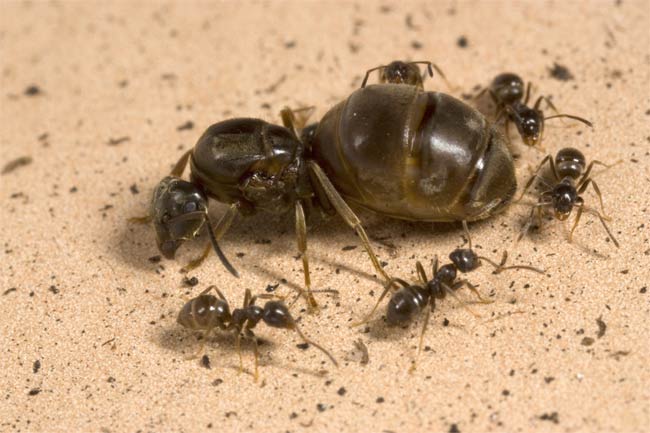In an astonishing event in the natural world, an ant queen has been seen producing offspring from two completely distinct species. This uncommon occurrence provides fresh perspectives on genetics, evolution, and the complex social interactions within insect communities.
The discovery, reported by entomologists after careful observation and genetic analysis, challenges conventional understanding of ant reproduction. Typically, a queen ant produces offspring of her own species, ensuring colony uniformity and social cohesion. However, in this unusual case, the queen was found to have generated offspring that belong to two separate species, a scenario that scientists describe as extraordinary and highly rare.
This phenomenon provides a unique opportunity for researchers to examine the underlying mechanisms of reproductive biology, hybridization, and genetic plasticity in insects. The implications extend beyond ants, offering a window into evolutionary processes that may occur under specific environmental or genetic conditions.
The study of what causes the phenomenon
Ant colonies are often celebrated for their complex social structures, with the queen serving as the reproductive heart of the colony. In most species, she produces eggs that develop into workers, soldiers, or new queens, all sharing a consistent genetic lineage. The emergence of offspring from two species disrupts this norm and prompts questions about genetic compatibility, reproductive strategies, and species boundaries.
Scientists participating in the research carried out comprehensive DNA tests to verify the identities of the progeny. Their discoveries indicated that the queen’s eggs had unexpectedly varied at the genetic level, leading to one group developing into members of her own species while another group belonged to a species that is closely related. Events like these are extremely uncommon and propose either unidentified reproductive processes or atypical environmental factors that impact gene expression.
The occurrence is not just intriguing but also holds scientific importance. It questions established beliefs regarding reproductive isolation and species loyalty in ants. Gaining insight into the reasons and mechanisms behind this two-species reproduction might reveal wider concepts of evolution, adaptation, and genetic versatility in social insects.
Implications for evolutionary biology and genetics
Esta revelación tiene profundas consecuencias para la biología evolutiva. Usualmente, las especies se definen por su capacidad de reproducirse exitosamente dentro de un linaje específico. No obstante, el caso de una reina hormiga produciendo dos especies difumina estos límites, sugiriendo que en determinadas circunstancias, las barreras reproductivas pueden ser superadas o evitadas.
Certain researchers propose that these events may signify an uncommon type of crossbreeding or genetic irregularity, which could offer benefits for evolution in specific surroundings. For instance, the creation of progeny from two different species might enable a community to vary its labor force, adjust to fresh ecological roles, or enhance durability in the face of environmental challenges.
From the perspective of genetics, the scenario represents a natural study into gene expression and inheritance. Scientists have the opportunity to analyze how one person can impact the development of descendants with varied characteristics and investigate the molecular processes that enable such uncommon reproductive results. These findings might have implications extending past entomology, contributing to wider research on genetic regulation, mutation, and the evolution of complex features.
Group interactions inside the community
The birth of two species within one colony raises questions about social cohesion and organization. Ant colonies rely on communication, chemical signaling, and cooperative behavior to function efficiently. Offspring from two distinct species could introduce new challenges for colony management, including differences in behavior, task specialization, or interaction patterns.
Entomologists noted that, in spite of genetic variations, the colony maintained impressive stability. This finding implies that ant social systems might be more flexible than once believed, as they can incorporate genetic diversity without falling apart. It also underscores the possible influence of environmental signals and chemical communication in preserving unity even with genetic differences.
Grasping the ways in which colonies manage these irregularities might illuminate foundational aspects of societal evolution. Specifically, it could uncover how collaborative structures sustain themselves despite genetic differences, providing insights similar to research on social conduct in various species, humans included.
Environmental factors and potential triggers
While the precise causes of this unusual reproductive event remain under investigation, scientists are exploring several potential triggers. Environmental stressors, such as changes in temperature, food availability, or habitat disruption, may influence gene expression in ways that promote unusual reproductive outcomes.
Additionally, interactions with species closely related in the neighboring environment might influence this. Some scientists propose that contact with chemical signals or pheromones from other species could initiate developmental processes resulting in cross-species reproduction. If validated, this mechanism would demonstrate a sophisticated connection among genetics, environment, and social behavior that is more complex than previously understood.
Future studies are likely to focus on replicating these conditions in controlled laboratory settings, testing how environmental variables influence reproductive outcomes. These experiments could help clarify whether the phenomenon is a rare anomaly or a natural strategy that occurs under specific ecological circumstances.
Wider influence on entomology and conservation efforts
The discovery of a queen producing offspring from two species has significant implications for entomology and biodiversity research. It challenges assumptions about species boundaries, reproductive fidelity, and colony dynamics, providing new avenues for study in evolutionary biology and ecology.
Additionally, the discovery might have an impact on conservation approaches. Numerous ant species perform essential functions in ecosystems, including pollination, seed dispersal, and soil engineering. By comprehending how genetic diversity and atypical reproductive behaviors impact the resilience of colonies, it could guide initiatives to safeguard threatened species and uphold ecological equilibrium.
Through the investigation of uncommon phenomena such as interspecies breeding, researchers acquire understanding about the resilience and intricate nature of social insects. This information might aid in predicting how species react to changes in their environment, the presence of invasive species, or the segmentation of habitats, thereby improving efforts in conservation and environmental management.
Interest from the public and learning potential
Unique findings such as this garner public attention and offer outstanding avenues for scientific learning. The concept of a queen ant producing two different species is visually captivating, straightforward to explain, and inherently fascinating. Instructors can utilize this instance to illustrate genetics, evolution, and societal interactions in an engaging and unforgettable manner.
Beyond classrooms, such stories highlight the unpredictable and wondrous aspects of the natural world. They remind the public that science is full of surprises and that even well-studied organisms can reveal new mysteries. This sense of wonder is essential for cultivating a broader appreciation for research and the value of studying diverse ecosystems.
The observation of a queen ant producing offspring of two distinct species is an extraordinary event with implications for genetics, evolution, ecology, and social behavior. It challenges conventional understanding of species boundaries, provides insights into the adaptability of social insect colonies, and sparks public curiosity about the natural world.
As researchers persist in exploring the genetic, environmental, and behavioral elements behind this occurrence, the results are expected to enhance the broader understanding of evolutionary processes and reproductive biology. Although infrequent, such findings underscore the intricacy and uncertainty of life, showing that even in the structured realm of ant colonies, unexpected events may occur.
Este evento destaca la importancia de seguir investigando los insectos sociales y sus funciones ecológicas. Al examinar anomalías como la reproducción de especies duales, los científicos obtienen una comprensión más profunda de la adaptación, la resiliencia, y la interacción entre la genética y el ambiente, lo que representa el interminable encanto del mundo natural.




